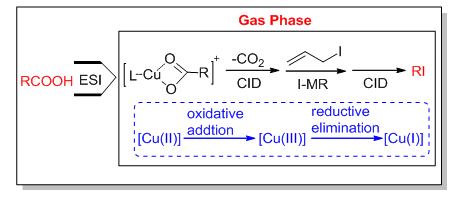摘要/Abstract

提供了一种通过电喷雾电离质谱在气相中对一类有机铜配体复合物的合成方法.通过碰撞诱导解离和分子-离子反应,在离子阱质量分析器中完成了气相中铜催化的脱羧碘化反应.羧酸(RCOOH)作为反应物最终通过碰撞诱导解离技术和分子-离子反应转化为碘代烃(RI).在整个反应过程中,观察到了铜的价态变化,由此也对羧酸的脱羧碘化反应的反应机理进行了解释.同时,不同的羧酸和双氮配体也适用于该反应体系.该方法检测了一类有机铜复合物的气相反应活性,并对液相中铜催化的脱羧碘化反应的反应机理研究提供了重要信息.
关键词: 有机铜复合物, 碰撞诱导解离, 分子离子反应, 脱羧碘化, 含氮双齿配体
Organocopper complexes play the key role in Cu-catalyzed organic reaction. This manuscript offered a method to synthesize ligand-ligated organocopper complexes. Copper acetate was used as the catalyst and 2-(aminomethyl)pyridine (2-AMP) as the ligand to react with benzoic acid to generate the organocopper complex. This complex (A1) was easily transferred from solution to gas phase via electrospray ionization mass spectrometry (ESI-MS). Firstly, the collision-induced dissociation (CID) experiment of complex ion A1 was carried out in the ion-trap analyzer to investigate the gas-phase reactivity of it (the single isotope ion with 63Cu was isolated and used in MS/MS and next ion-molecule reaction). The decarboxylation reaction was taken place upon CID to generate the fragment ion B1. Next, the ion-molecule reaction (I-MR) of B1 was introduced after ion B1 was isolated, while allyl iodide was used as the neutral reagent. The iodine group transfer product ion C1 was obtained from the ion-molecule reation. The valence state of the central metal Cu changed from +2 in B1 to +3 in C1 during this process. Then ion A3 was dissociated to form the Cu(I) complex D1 with a neutral loss of iodobenzene upon CID. During these steps, the reagent benzoic acid reacted with allyl iodide in the gas phase with Cu2+ as catalyst and 2-AMP as ligand to produce iodobenzene, thus the copper-catalyzed decarboxylative iodination reaction was created in the gas phase. From the result, the mechanism of decarboxylative iodination reaction was speculated and carefully studied. Meanwhile, this reaction was also suitable for different carboxylic acids and bidentate nitrogen ligands. The aim of this manuscript is to study the reactive copper complexes in isolated environment and solvent free-condition. The gas phase mass spectrometric results supported the proposed mechanism. This method not only detected the gas-phase reactivities of a series of organocopper complexes, but also provided significant information of the mechanism of copper-catalyzed decarboxylative iodination reaction in the condensed phase.
Key words: organocopper complex, collision-induced dissociation, ion-molecule reaction, decarboxylative iodination, bidentate nitrogen ligand
PDF全文下载地址:
点我下载PDF
